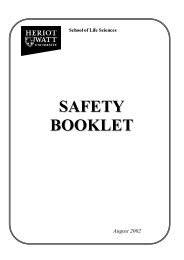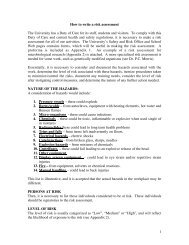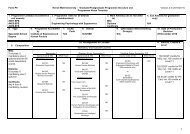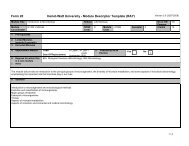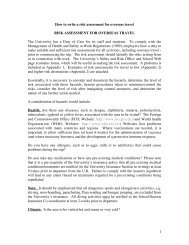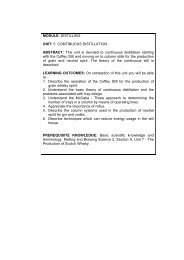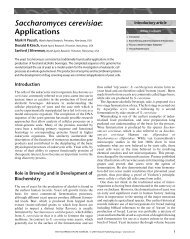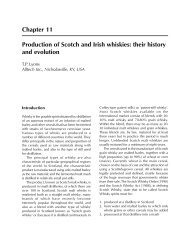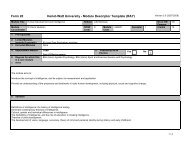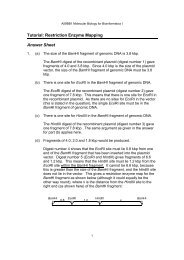Big Five Factors of Personality and Replicated Predictions of Behavior
Big Five Factors of Personality and Replicated Predictions of Behavior
Big Five Factors of Personality and Replicated Predictions of Behavior
Create successful ePaper yourself
Turn your PDF publications into a flip-book with our unique Google optimized e-Paper software.
BIG FIVE PREDICTORS<br />
415<br />
Results<br />
<strong>Big</strong> <strong>Five</strong> Scale Summary Statistics<br />
Table 1 lists some <strong>of</strong> the statistics obtained from the four<br />
personality assessments <strong>of</strong> participants using the FF–NPQ (two<br />
assessments), the NEO–FFI, <strong>and</strong> the NEO–PI–R. Comparison <strong>of</strong><br />
the scale means for the three different inventories shows that,<br />
although no measure was conspicuously far from the midpoint <strong>of</strong><br />
its items’ rating scale (7-point rating scale for the FF–NPQ items,<br />
<strong>and</strong> 5-point rating scale for the NEO–FFI <strong>and</strong> NEO–PI–R items),<br />
the Neuroticism scale scores were below that midpoint in all four<br />
assessments, whereas all other scale scores were above the midpoint.<br />
The apparent differences in the st<strong>and</strong>ard deviations <strong>of</strong> the<br />
factors’ mean scores between the nonverbal measures <strong>and</strong> the<br />
verbal measures most likely reflect the differences in the item<br />
rating scales used by the inventories (i.e., 7-point vs. 5-point rating<br />
scales, respectively).<br />
The alpha coefficients <strong>of</strong> internal consistency are shown for<br />
each <strong>Big</strong> <strong>Five</strong> scale in the last column <strong>of</strong> Table 1 <strong>and</strong> indicate good<br />
levels <strong>of</strong> reliability for all measures. Note that the NEO–PI–R<br />
scales had higher reliabilities, in general, than did the other scales.<br />
This is no doubt due to the length <strong>of</strong> the former scales, at 48 items<br />
each, compared with only 12 items each for the other scales.<br />
Observe also that the FF–NPQ reliabilities were slightly higher<br />
than were the NEO–FFI reliabilities for the scales <strong>of</strong> Extraversion,<br />
Openness, <strong>and</strong> Agreeableness but slightly lower for Neuroticism<br />
<strong>and</strong> Conscientiousness.<br />
Table 1<br />
Summary Statistics for <strong>Big</strong> <strong>Five</strong> <strong>Personality</strong> Factor Measures<br />
Measure No. items M SD <br />
FF–NPQ (n 178)<br />
Neuroticism 12 3.61 1.01 .81<br />
Extraversion 12 4.36 1.08 .87<br />
Openness 12 4.65 1.02 .85<br />
Agreeableness 12 5.21 1.04 .85<br />
Conscientiousness 12 4.52 0.75 .79<br />
FF–NPQ (n 142)<br />
Neuroticism 12 3.85 0.98 .80<br />
Extraversion 12 4.16 0.92 .81<br />
Openness 12 4.63 0.91 .82<br />
Agreeableness 12 5.15 0.91 .80<br />
Conscientiousness 12 4.74 0.76 .74<br />
NEO–FFI (n 273)<br />
Neuroticism 12 2.65 0.68 .86<br />
Extraversion 12 3.66 0.49 .79<br />
Openness 12 3.36 0.52 .72<br />
Agreeableness 12 3.65 0.50 .76<br />
Conscientiousness 12 3.45 0.60 .86<br />
NEO–PI–R (n 135)<br />
Neuroticism 48 2.97 0.40 .89<br />
Extraversion 48 3.50 0.36 .87<br />
Openness 48 3.42 0.36 .86<br />
Agreeableness 48 3.41 0.34 .87<br />
Conscientiousness 48 3.27 0.36 .87<br />
Note. Mean scores represent the average 7-point item rating for the<br />
FF–NPQ scales <strong>and</strong> the average 5-point item rating for the NEO–FFI <strong>and</strong><br />
NEO–PI–R scales. FF–NPQ <strong>Five</strong>-Factor Nonverbal <strong>Personality</strong> Questionnaire;<br />
NEO–FFI NEO <strong>Five</strong>-Factor Inventory; NEO–PI–R Revised<br />
NEO <strong>Personality</strong> Inventory.<br />
<strong>Big</strong> <strong>Five</strong> Scale Intercorrelations<br />
Table 2 shows the monomethod–heterotrait correlations <strong>of</strong> the<br />
<strong>Big</strong> <strong>Five</strong> factors measured using different inventories. The overall<br />
level <strong>of</strong> scale relatedness in each <strong>of</strong> the four data sets was about the<br />
same, as indicated by the size <strong>of</strong> the first eigenvalue <strong>of</strong> each<br />
correlation matrix (1.82, 1.99, 1.74, <strong>and</strong> 1.89, respectively). However,<br />
some differences can be discerned between the specific<br />
correlations among the FF–NPQ scales <strong>and</strong> those among the two<br />
verbal measures. For example, Neuroticism was consistently correlated<br />
negatively with the other four factor scales in both the<br />
NEO–FFI <strong>and</strong> the NEO–PI–R inventories (consistent with a desirability<br />
response bias interpretation). In the case <strong>of</strong> the FF–NPQ,<br />
however, those correlations were slightly positive, even noticeably<br />
positive in the case <strong>of</strong> Neuroticism’s correlation with Conscientiousness<br />
(consistent with an acquiescence bias interpretation—<br />
with the exception <strong>of</strong> the Agreeableness scale, the items <strong>of</strong> the<br />
FF–NPQ scales are all positively keyed.) Other differences were<br />
that Extraversion <strong>and</strong> Agreeableness were positively correlated in<br />
the verbal scales but were uncorrelated in the nonverbal scales <strong>and</strong><br />
that Openness <strong>and</strong> Conscientiousness were correlated in the FF–<br />
NPQ inventory but not in the NEO–FFI or NEO–PI–R inventories.<br />
The differences in scale correlations described above suggest<br />
that the nonverbal items <strong>and</strong> the verbal items may be measuring<br />
somewhat different aspects <strong>of</strong> the same <strong>Big</strong> <strong>Five</strong> factors. However,<br />
despite these differences in heterotrait correlations, the FF–NPQ<br />
correlated .55 on average with the corresponding NEO–FFI factor<br />
scales in the first sample’s data (Neuroticism .57, Extraversion<br />
.51, Openness .64, Agreeableness .48, Conscientiousness<br />
.56; in contrast, the mean absolute value <strong>of</strong> the<br />
heteromethod–heterotrait correlations was appropriately low at<br />
only .11). Coincidentally, the FF–NPQ also correlated .55 with the<br />
NEO–PI–R scales in the second sample’s data (Neuroticism .51,<br />
Extraversion .57, Openness .63, Agreeableness .58, Conscientiousness<br />
.46, with a mean absolute heteromethod–<br />
heterotrait correlation <strong>of</strong> only .17). These convergent validity<br />
values between the verbal <strong>and</strong> nonverbal scales are not much lower<br />
than the .59 mean correlation reported between NEO–FFI factor<br />
scales <strong>and</strong> adjective-based <strong>Big</strong> <strong>Five</strong> marker variables (Costa &<br />
McCrae, 1992, p. 54).<br />
The results <strong>of</strong> the heterotrait <strong>and</strong> monotrait comparisons for the<br />
present <strong>Big</strong> <strong>Five</strong> inventories suggest a convergence <strong>of</strong> the corresponding<br />
factor measures. However, the verbal <strong>and</strong> nonverbal<br />
scales are probably measuring slightly different variants <strong>of</strong> the<br />
same personality dimensions. As has been noted elsewhere (e.g.,<br />
Paunonen et al., 1992), certain behaviors are more easily represented<br />
with verbal items than with nonverbal items. This limits, to<br />
some extent, the range <strong>of</strong> trait content that can be incorporated in<br />
nonverbal personality scales <strong>of</strong> the type found in the FF–NPQ.<br />
<strong>Replicated</strong> Significant <strong>Big</strong> <strong>Five</strong> Predictors<br />
As an overall summary <strong>of</strong> how well the <strong>Big</strong> <strong>Five</strong> inventories<br />
could predict the present criteria, I first computed the multiple<br />
correlations between the five factor scales in an inventory <strong>and</strong> each<br />
behavior criterion. Averaged across all 27 criteria used in this<br />
study, the mean multiple correlations for the two FF–NPQ data<br />
sets were .27 <strong>and</strong> .28 (n 178 <strong>and</strong> n 142, respectively). The<br />
corresponding mean multiple correlations were .27 for the NEO–



